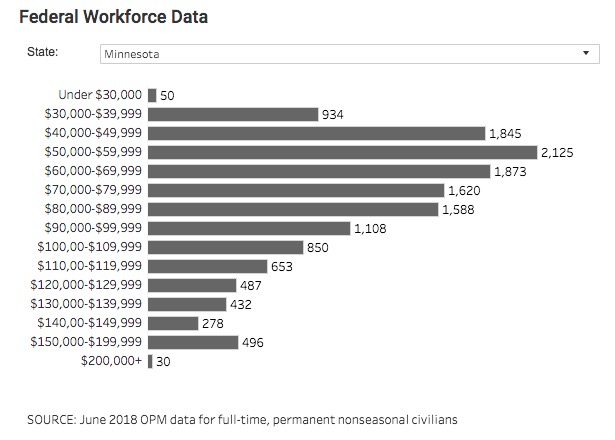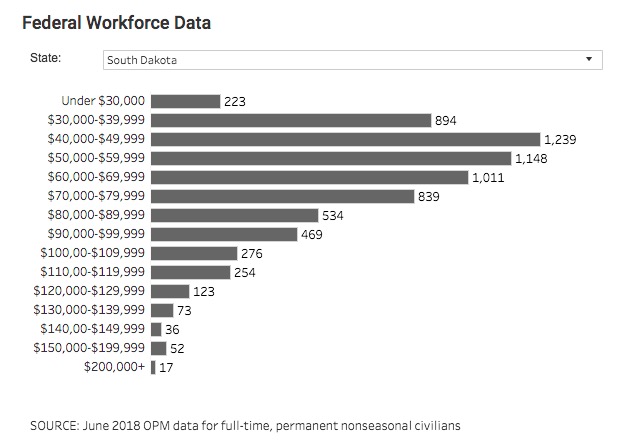Even Uncle Sam takes advantage of South Dakota’s low-wage business climate. Mike Maciag of Governing finds that while only 6% of federal employees make less than $40,000 a year, in South Dakota, that percentage is 15.5%.
Maciag finds that low pay arises in part due to the federal government’s locality-based pay schedules: in the Twin Cities, a Grade 1 Step 1 federal employee gets $23,175; in South Dakota (and other places not included in the main metros), that same starting position draws $21,672. At the other end, the highest pay slot, Grade 15, starts at $129,690 in Minneapolis but only $121,280 in Sioux Falls or Aberdeen. That’s a 6.5% gap.



Look at those distributions, and you see the number of workers peak at a lower pay grade in South Dakota than in Minnesota or the U.S. as a whole and drop off sooner. We also apparently lack executive opportunities, since we don’t see the same size bump in the $150K–$199K bracket that appears nationwide.
South Dakota has the highest percentage of low-paid federal employees, whether we count down from $30K, $40K, $50K, or $60K. Federal workers are more likely to draw a better wage in every other state.
Maciag says South Dakota’s relatively low federal paychecks also relate to the types of federal jobs available:
Where agency facilities are located — along with types of workers they employ — further explain why some states have more lower-paying federal jobs than others. About 31 percent of all Department of Veterans Affairs workers earn less than $50,000, the top share of any federal cabinet agency, and the massive agency maintains a presence in every state. The Defense Department and U.S. Army also report relatively higher numbers of employees in this lower pay bracket [Mike Maciag, “States with Substantial Numbers of Lower-Wage Federal Workers,” Governing, 2019.02.05].
Indian Health Service doesn’t pay all that great, either: Maciag says a quarter of South Dakota’s IHS employees are earning less than $40K a year.
The takeaways:
- If you’re a worker, go work for the feds across the border.
- If you’re Uncle Sam, decrease federal spending by moving lots of federal offices to South Dakota!
If a Republican stands on a hill and yells out, “Bring your jobs to South Dakota. Our cost of living is lower so you can pay your workers less.” there’s a chance Republicans in Washington might just believe the lie and take you up on the offer. #NoseSpiteFace
I again ask the question: Why? Why are we a low-paying state? Who made/makes that decision? Is everyone being low paid OK with that?
Economic Stockholm syndrome?
o, that’s a campaign slogan waiting to happen. If Dems are in the majority, things will change for the better!
Porter, but that seems to be the problem to solve: if SD citizens believe they deserve better, then WHY do they continue (and often in GREAT majority) elect those who perpetuate the very system that uniquely exploits them?
If people are not willing to vote their own best interests, how do Democrats/Liberals/the Left then create an interest they will vote for? Clearly the GOP/Conservatives/Right has cracked that code.
Federal locality pay is based upon a comparison of non-Federal job salaries to Federal job salaries in a specific region/city for the same levels of work. Below is a link for some further information, such as study results, who makes the decisions, etc.
https://www.opm.gov/policy-data-oversight/pay-leave/salaries-wages/fact-sheets/
I always wondered about this. If two people are doing the same job in Sioux Falls and Minneapolis, why is one paid more? Equal pay for equal work should apply, and the locale you are doing the work in should not be a factor. What if the person in Sioux Falls is female and the one in Minneapolis is male? Does that set up a sex discrimination case? I’d like to see the sex ratios in federal jobs in low pay states versus high pay states.
My guess is the politics (and economics) of resentment keeps South Dakotans from actually moving up the ladder of success. South Dakotans pride themselves on being good workers, and they are. Why aren’t Thune, Rounds and Johnson standing up for South Dakota workers?
Now… calculate how much of that pay gets taken in the form of taxes in MN v. SD … I really don’t see the difference as far as cost of living, but the cost of taxes is noticeable..
I am all for taking the ‘location based increases’ away. Let’s do that!!!
Yes, there is no reason in the federal or state governments for “locality pay”. One chooses to live in Sioux Falls and should not receive more pay for that choice than one living in Timber Lake.
Donald Pay – Couldn’t the same be said for any number of job comparisons between a large city and a small one. I could be wrong, but I wouldn’t think an 8th grade math teacher with a master’s degree and 4 years of experience at a school in Sioux Falls would make the same salary as an 8th grade math teacher with a master’s degree and 4 years of experience at a school in Minneapolis, even though they have the same education level, the same amount of experience and do the same job. They wouldn’t probably even make the same in a comparison within the same state, say between Sioux Falls and Oldham/Ramona. I know the teacher salaries suck in South Dakota, so that probably wasn’t the best job field to do a comparison with, but I would bet it applies to other jobs as well.
I would like to see national guard stats and EAFB
Low taxes. low services. Fact of life. You make trade offs when your government won’t raise taxes.
Mike from Iowa … No, you just get to pay for the services you want with your own money instead of subsidizing it all with tax dollars to make it ‘free’ or cheaper …
A report like this makes you want to yell at my senators and congressman and tell them to correct this scam.
Who are the bean counters in Washington, D.C. that develop these unfair pay formulas?
This mess is like Social Security raises being based on the price of gas.
A South Dakota Social Security Administration processor of claims does exactly the same job that one in any other state does. Why would they get paid less in SD? Same with a HUD case worker.
e.g. A federal worker Grade 1 – Step 10 in SD earns $27,114 yearly while a federal worker Grade 1 – Step 10 in Denver earns $29,488 doing exactly the same job classification. It’s called INCORPORATING A LOCALITY PAYMENT by the government. I call it a hose job.
* States with vocal and active federal legislators can get the Locality Payment adjusted. It happens all the time. Just not in complacent, go along to get along SD.
David B: interesting link! So the feds look at prevailing wages, not cost of living directly?
You will find government provided police and fire protection a better bargain than private fire and security protection. Private snow removal is expensive.